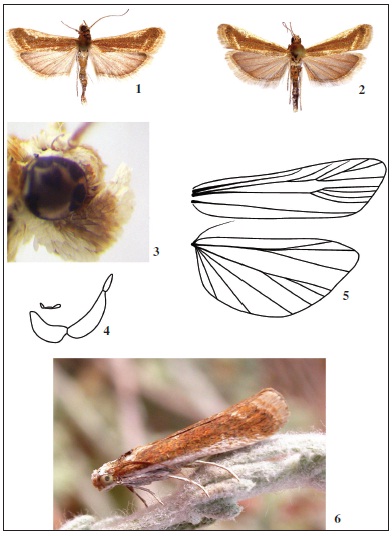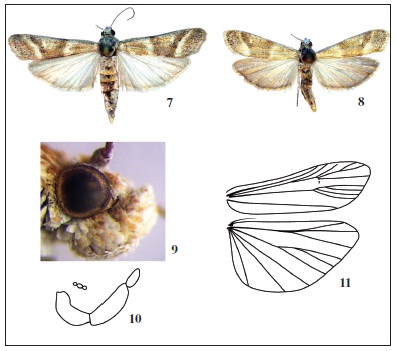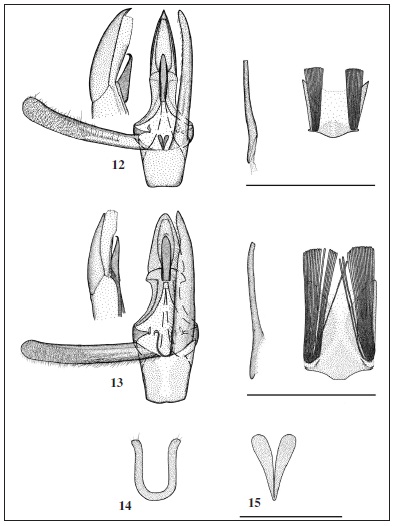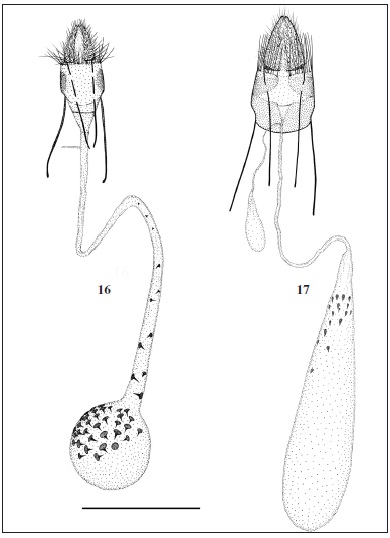

Artículos
Description of two new species of the genus Ancylosis Zeller, 1839 from Russia and Kazakhstan (Lepidoptera: Pyralidae, Phycitinae)
Descripción de dos nuevas especies del género Ancylosis Zeller, 1839 de Rusia y Kazajstán (Lepidoptera: Pyralidae, Phycitinae)
Description of two new species of the genus Ancylosis Zeller, 1839 from Russia and Kazakhstan (Lepidoptera: Pyralidae, Phycitinae)
SHILAP Revista de Lepidopterología, vol. 46, no. 182, 2018
Sociedad Hispano-Luso-Americana de Lepidopterología
Received: 12 August 2017
Accepted: 15 September 2017
Published: 30 June 2018
Abstract: Ancylosis triangulicosta Tsvetkov, sp. n. is described from Astrakhan Province of Russia and Mangistau Province of Kazakhstan. Ancylosis mangistauensis Tsvetkov, sp. n. is described from Mangistau Province of Kazakhstan. Male and female genitalia of the described species are illustrated.
Keywords: Lepidoptera, Pyraloidea, Pyralidae, Phycitinae, Ancylosis, new species, Kazakhstan, Russia.
Resumen: Se describe Ancylosis triangulicosta Tsvetkov, sp. n. de la provincia de Astracán en Rusia y de la provincia de Mangystau en Kazajstán. Se describe Ancylosis mangistauensis Tsvetkov, sp. n. de la provincia de Mangystau en Kazajstán. De las especies descritas, se ilustra la genitalia del macho y de la hembra.
Palabras clave: Lepidoptera, Pyraloidea, Pyralidae, Phycitinae, Ancylosis, new species, Kazajstán, Rusia.
Introduction
Descriptions in the present paper are based on material collected by the author in poorly studied regions of Russia (the south of Lower Volga, Astrakhan Province) and West Kazakhstan (Mangistau Province). The expeditions to these areas in May and June (2016-2017) revealed a variety of Pyraloid species of subfamily Phycitinae. Among the collected samples two species turned to be undescribed. After a detailed studying they are referred to new species of genus Ancylosis Zeller, 1839.
Ancylosis triangulicosta Tsvetkov, sp. n. (figs. 1-6, 12, 15, 16)
Type material: Holotype ♂, Russia, Astrakhan Province, 18 km NE of vill. Dosang, 25-V-2016, leg. E. Tsvetkov. Paratypes (7 ♂♂, 3 ♀♀): Russia, Astrakhan Province, 18 km NE of vill. Dosang, 6 ♂♂, 1 ♀, 25-V-2016, leg. E. Tsvetkov; Kazakhstan, Mangistau Province, 11 km of Beineu, 1 ♂, 19-VI2017, leg. E. Tsvetkov; Kazakhstan, Mangistau Province, 43 km SE of Shetpe, sands, 2 ♀♀, 8-VI2017, leg. E. Tsvetkov. All type specimens are deposited in the collection of Zoological Institute, St. Petersburg.
Description: Head and body. Ventral part of abdomen and thorax white, dorsal part reddishbrown or yellowish brown. Legs white with partly dark brown tarsus. Frons convex, white or whitishwith slight yellowish tinge, sometimes with small inclusions of yellowish brown scales. Vertex light brown, partly white. Chaetosemata (brownish scales) present behind ocelli. Antennae 3/4 of the forewing with tiny sharp spine on the last flagellomere. Scape usually whitish on ventral side and light brown on dorsal side, nearly 2-2.5 times as long as wide. Dorsal side of flagellum chequered (dark brown and whitish areas on each segment), ventral side covered with white scales. Cilia whitish, in males it is longer (2/3 of segment width) on first 6-8 flagellomeres and shorter (less than 1/2 of segment width) on the rest of flagellum. In females cilia very short on all flagellomeres (1/3 of segment width or shorter). Labial palps 1.5 diameter of eye in length, pointed up and ahead (figs. 3-4), covered with white scales. Large yellowish brown or reddish brown spot located laterally on the dorsal part of the first segment and on the whole second segment. Maxillary palps small with elongate thin segments (fig. 4), covered with small flat scales.
Wings (figs. 1, 2, 6). Venation (fig. 5): Forewing. Length 6-8 mm. Forewing relatively broad, almost triangular. Its costal edge straight, apex rounded. Ground color reddish brown. White elements of pattern are costal streak, discal spot, postmedial line and streak along A vein. The shape of costal streak resembles a triangle. It is usually evenly (sometimes abruptly) narrowing from discal cell to the base of the wing so, that in basal area it occupies less than a half of sector between costal edge and Sc vein. Costal streak is also narrowing from the cell outwards (but not reaching the apex) and it is the widest at discal cell. In rare cases discal spot absent, it is merged with costal streak if expressed. Postmedial line usually thin and always interrupted reaching only 1/2-2/3 of the wing from hind margin. The streak along A vein changeable and often absent. It sometimes occupies postbasal area and bounded by postmedial line. In some cases only short trace of antemedial line is present instead of the streak. Fringe yellowish brown. Forewing underside brown. Hindwing brown or grayish brown with darker submarginal area. Fringe light brown. Hindwing underside light brown with darker submarginal area and sector between Sc+Rs vein and costa.
Male genitalia (figs. 12, 15): Uncus elongate with sharp apex. Gnathos relatively long and narrow with almost parallel edges (in ventral view), tongue shaped and curved up at apex. Lateral branches of gnathos curved, narrowing distally. Small triangular transtilla components attached to lateral lobes of tegumen. V-shaped anellus consists of a pair of petal-like lobes (fig. 15), which sometimes are merged at the base. Valva long and narrow with almost parallel ventral edge and costa, widely rounded at apex. Sacculus narrow, occupies nearly half of ventral edge of valva. Costa well scleridied. Small bristles cover inner surface of valva in its distal half. This bristly area forms narrow and elongate projection pointed to valva base. Vinculum trapezoidal. Aedeagus long and thin with slightly thinner distal half. Eighth sternum convex anteriorly. Well sclerified side areas of the sternum form lateral angular convexities of posterior margin. Culcita present as a pair of scale tufts. The scales are some longer (1.1-1.2 times) than eighth sternum and not very much protruding beyond its posterior edge.
Female genitalia (fig. 16): Papillae analis relatively small, flat, tapering to pointed apex. Anterior apophyses nearly equal to posterior apophyses and twice as long as papillae analis. Eighth tergum broad with convex anterior margin and straight posterior margin. Antrum membranous, conical. Ductus bursae long and thin, membranous, widening gradually from 1/2 of its length to corpus bursae. Nearly 10 cornuti of different size scattered along ductus in its anterior half. Bursa membranous, small and spherical with large group of cornuti (30-35) located on the side. Each cornutus in bursa and in ductus bursae bears large round base.
Diagnosis: A. triangulicosta can be separated from all known Ancylosis species by the shape of costal streak and reddish brown uniform coloration of the forewing. The shape of anellus in male genitalia is special, so the described species can be also distinguished from any other Ancylosis species by this feature. Similar A. hecestella Roesler, 1970 is known from Mongolia. In comparison with this species the costal streak is narrowed basally in A. triangulicosta. In male genitalia gnathos is widened at its base in A. hecestella (twice wider than in distal part), while gnathos of A. triangulicosta has constant width or even slightly narrower at its base. Anellus is U-shaped in A. hecestella (fig. 14). V-shaped anellus of A. triangulicosta is formed with a pair of elongate petal-like vanes (fig. 15). Some differences in palps structure between these species are also worth mentioning. Maxillary palps are nearly 1/3 of third segment of labial palps in A. hecestella and nearly the whole third segment of labialpalps in the described species (fig. 4).
Biology: A. triangulicosta inhabits different types of steppes and semidesert lands with Artemisia. It seems to be widely distributed in the south of Lower Volga (Astrakhan Province) and in West Kazakhstan. According to our observations it occurs by single specimens and it can be abundant on sandy soils.
Ancylosis mangistauensis Tsvetkov, sp. n. (figs. 7-11, 13, 17)
Type material: Holotype ♂, Kazakhstan, Mangistau Province, 7 km NE of vill. Taushchik, 14-V2016, leg. E. Tsvetkov. Paratypes (8 ♂♂, 3 ♀♀): Kazakhstan, Mangistau Province, 7 km NE of vill. Taushchik, 4 ♂♂, 14-V-2016, leg. E. Tsvetkov. Kazakhstan, Mangistau Province, 8 km NW of vill. Taushchik, 4 ♂♂, 3 ♀♀, 11-V-2016, leg. E. Tsvetkov. Type material is deposited in the collection of Zoological Institute, St. Petersburg.
Description: Head and body. Dorsal part of thorax, vertex and both sides of antennal scape covered with mixture of white and yellowish red scales. Legs, ventral part of abdomen and thorax almost white with slight creamy tinge. Abdomen grayish creamy on the dorsal side. Frons convex, covered with white and creamy scales. Chaetosemata (whitish scales) present behind ocelli. Antennae 3/5 of the forewing with tiny sharp spine on the last flagellomere. Scape nearly two times as long as wide. Dorsal side of flagellum chequered (dark brown and white areas on each segment). Cilia very short, in males 1/4-1/3 of segment width and much shorter in females. Labial palps 1.6-1.8 diameter of eye in length, pointed up and ahead, covered with mixture of white and yellowish red scales (figs. 9-10). Maxillary palps very small and not protruding beyond the edge of clypeus, consist of spherical or drop like segments (fig. 10), covered with small flat scales.
Wings (figs. 7-8). Venation (fig. 11): Forewing. Length 8-10 mm. Forewing nearly triangular with rounded apex and tornus. Costal edge straight or slightly sinuate, curved at apex. Basal area reddish gray or reddish brown. Antemedial white line straight or curved not very much, often thick with blurred edges. Sometimes the line clouded by reddish suffusion. Postmedial white line oblique (nearly parallel to outer margin of the wing) and slightly curved. The line in some cases suffused by grayish scales at costa. Area between antemedial and postmedial lines usually dark gray with some reddish elements of pattern. Reddish color can be more or less extensive in this area. Dark gray thick stripes mark antemedial and postmedial white lines from outside and inside respectively. These stripes sometimes blurred and unclear, especially if suffused by reddish scales. White suffusion expressed in small area adjacent to costa between the stripes. Small white discal spot often expressed. Submarginal area relatively broad, reddish gray, covered with mixture of white, reddish and dark gray scales. Fringe brownish gray. Forewing underside brown sometimes with creamy white subcostal area. Hindwing light brown or whitish with darker submarginal area. Fringe whitish, usually with brown basal third. Hindwing underside light brown or whitish. Sector between Sc+Rs vein and costa usually darker.
Male genitalia (fig. 13): Uncus elongate, nearly triangular with rounded apex. Gnathos relatively long with parallel edges (in ventral view), tongue shaped and slightly curved up at apex. Lateral branches of gnathos curved, angulate on sides basally. Lateral lobes of tegumen relatively large, tapering, bear small transtilla components. Anellus U-shaped with hooked sclerified distal part of the lobes. Valva long and narrow with parallel ventral edge and costa, widely rounded at apex. Sacculus occupies nearly half of ventral edge of valva. Costa well sclerified. Small bristles cover sacculus and inner surface of valva in its distal half. Bristly area in basal half of valva forms narrow and elongate projection pointed to valva base. Vinculum rather large, trapezoidal. Aedeagus long and thin, slightly curved. Eighth sternum convex anteriorly with flatly trapezoidal anterior margin. Sclerified side areas of the sternum form lateral angular convexities of posterior margin. Culcita present as a pair of scale tufts. The scales are considerably longer (1.3-1.4 times) than eighth sternum and much protruding beyond its posterior edge.
Female genitalia (fig. 17): Papillae analis relatively small, flat, tapering to pointed apex. Anterior apophyses slightly longer than posterior apophyses and 2.1-2.2 times longer than papillae analis. Eighth tergum broad with convex and widely rounded anterior margin and straight posterior margin. Antrum membranous, conical. Ductus bursae long and very thin, membranous. Corpus bursae elongate, pear shaped with conical posterior 2/3. A group of nearly 17 cornuti present in posterior half of corpus bursae. The cornuti more densely located in posterior 1/3 of corpus bursae. They are very small, weakly sclerified and hardly noticeable. Each cornutus flat, like small rounded plate with cranially pointed spine on the side.
Diagnosis: Several species resemble A. mangistauensis in appearance. Among them Ancylosis faustinella (Zeller, 1867) which has forewing with more uniform coloration. Submarginal area of the forewing narrower, white costal suffusion often expressed. The described species with motley and less uniform pattern of the forewing. Submarginal area of the forewing wider, costa lacks white suffusion or a streak. Genitalia of the compared species quite different in both sexes.
In Ancylosis gracilella (Ragonot, 1887) submarginal area of the forewing narrower than in A. mangistauensis. In female genitalia more numerous group of thorns occupies middle part of corpus bursae. Females of A. mangistauensis with less numerous group of thorns located posteriorly on corpus bursae. Male genitalia quite different.
Postmedial line on the forewing angled at hind margin in Ancylosis imitella Ragonot & Hampson, 1901 in distinguishing from A. mangistauensis with smooth postmedial line. Besides, labial palps shorter and pointed up and ahead in the described species, while the compared species with longer and pointed ahead labial palps. Genitalia of A. imitella and A. mangistauensis quite different.
Ancylosis smeczella Roesler, 1973 with larger maxillary palps (third segment of labial palps in length) enclosed to frontal side of clypeus. In female genitalia cornuti on corpus bursae larger and more numerous, located in posterior and middle part. In males uncus widely rounded, shorter gnathos widened at the base and tapered to apex. Maxillary palps very small in A. mangistauensis and not protruding beyond the edge of clypeus. In female genitalia less numerous group of smaller thorns located posteriorly on corpus bursae. Male genitalia with more pointed uncus and longer tongue-like gnathos of nearly constant width.
In distinguishing from A. mangistauensis, Ancylosis thalerella (Mabille, 1908) shows uniform coloration of the forewing, less oblique postmedial light line and white costal suffusion or a streak. Antemedial and postmedial light lines are not marked with dark stripes from outside and inside respectively. Females of A. thalerella with more numerous group of larger thorns occupying middle part of corpus bursae. The described species has more oblique postmedial line on the forewing, light lines contrasted from sides by dark stripes, white costal suffusion or a streak absent. The group of smaller thorns located posteriorly on corpus bursae in female genitalia.
In Ancylosis bruneella (Chrétien, 1911) submarginal area on the forewing narrower than in A. mangistauensis, postmedial and antemedial lines usually not contrast. Postmedial light line less oblique and not marked from inside by dark stripe. A. mangistauensis with a wider submarginal area on the forewing, very contrast postmedial and antemedial lines. Postmedial line more oblique and marked from inside by dark stripe (which sometimes unclear). Genitalia quite different.
A. mangistauensis can be mixed with some forms of A. samaritanella (Zeller, 1867) and A. harmoniella (Ragonot, 1887). But these two species are much unlike with A. mangistauensis in both male and female genitalia structure. A. samaritanella usually with thinner light lines on the forewing and more roughly angulate postmedial line. In A. harmoniella postmedial line strongly curved at M1 vein.
A little-known species Ancylosis convergens (Erschoff, 1874) (= dideganellaRoesler, 1973) is charecterized by different genitalia structure (SINEV, 1993; ROESLER, 1973).
Biology: The population inhabits southern calcic slope with saline and calcifilic vegetation. The species is possibly connected with semidesert calcic habitats as during the author's expedition around Mangistau no material was elsewhere found. A. mangistauensis was not rare in the found locality and it was often attracted to light.
BIBLIOGRAPHY
ASSELBERGS, J. E. F., 2010.– Order Lepidoptera, superfamily Pyraloidea (Part 2).– In A. VAN HARTEN (ed.).Arthropod fauna of the United Arab Emirates, 3: 554-563, 7 pls., 18 figs.
LERAUT, P., 2014.– Moths of Europe. Pyralids 2, 4: 440 pp., 69 pls. N. A. P. Editions, Verrières le Buisson.
RAGONOT, E. L. & HAMPSON, G. F.,1901.– Monographie des Phycitinae et des Galleriinae. In N. M. ROMANOFF. Mémoires sur les lépidoptères, 8: 602 pp., 34 pls., St. Pétersbourg.
ROESLER, R. U., 1970.– Die trifinen Phycitinae. Ergebnisse der zoologischen Forschungen von Dr. Z. Kaszab in der Mongolei (Lepidoptera, Pyralidae).– Reichenbachia, 13(7): 35-105, figs 1-30.
ROESLER, R. U., 1973.– Phycitinae, Trifine Acrobasiina. In H. G. AMSEL, F. GREGOR & H. REISSER. Microlepidoptera Palaearctica, 4: 752 + 137 pp., 170 pls. Verlag Georg Fromme & Co. Wien
SINEV, S. YU., 1993.– Type specimens of the narrow-winged pyralids (Lepidoptera, Phycitidae) described by N. G. Erschoff from the collection of Zoological Museum, Moscow State University.– Actias, 1(1-2): 91-98.
Figuras




Notes
Author notes